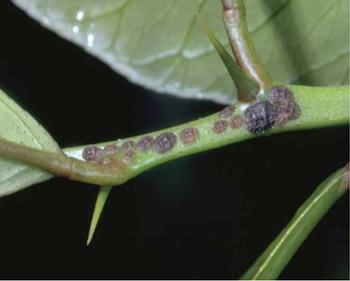Scale
-
AboutAdult scales are immobile with coverings that are one twenty-fifth to one-quarter inch long. Immature scales are small slow-moving bodies called crawlers that have legs which eventually drop off.
 Photo: Courtesy of UCIPM
Photo: Courtesy of UCIPMThere are two main groups of scale insects — soft and armored. Soft scales have a more rounded and convex cover that may be thin, cottony, powdery, or waxy and doesn't lift off. These are the pests that produce copious amounts of honeydew. Armored scales are tiny and flat; their hard, shield-like cover is composed of shed skins and wax and it can be separated from the insect's body. They don't secrete sticky honeydew. You need to know which type of scale is afflicting your plant, soft or armored, as the potential treatment may be significantly different
-
CategoryInsect
-
Signs/Symptoms
Damage resembles that of aphids and whiteflies - abundant sticky honeydew excreted by soft scales and certain other species
Black sooty mold growing on the honeydew
Discolored, distorted, or dying leaves, twigs, or branches, especially with armored scales.
-
Where
Plant branches, stems, twigs, trunks, foliage, or fruit.
-
When
Most scales overwintering on deciduous woody plants. In spring or summer crawlers emerge and most scales are in the young nymph stage.
Populations of some scales can increase dramatically within a few months when the weather is warm, and honeydew-seeking ants protect scales from their natural enemies.
-
Prevent
Provide plants with proper cultural care, especially irrigation.
Monitor plants to look for scale predators such as lady beetles or lacewings and parasite emergence holes in scale covers.
Use sticky barriers or insecticide baits to selectively control scale-tending ants.
Consider replacing problem-prone plants. Most scales are highly specific to certain plants.
-
Manage
Managing scale usually requires a multifaceted approach because of the pest's protective cover. Begin with good growing conditions and proper cultural care, especially appropriate irrigation.
Scale's natural enemies — small parasitic wasps and predators like beetles, lacewings, and some types of mites, may be able to contain low populations of the pest. Plant nectar or pollen-producing flowers to attract and support these natural enemies.
Disrupt the scale's pest-tending ants by pruning infested branches and removing weeds that provide a bridge between buildings or ground. Add sticky substances, like Tanglefoot, around the trunk that ants can't cross. If needed, utilize ant baits that attract the ants to the bait and that they in turn, take back to their nests.
If you need to move to some type of spraying treatment, timing is everything with these pests. Treat at a time when crawlers — the immature form that have legs and walk away from the mother scale to find new feeding sites — are the most active. A thorough spray of horticultural oil, applied either during the dormant season or soon after scale crawlers are active in late winter to early summer, can provide good control. Spray when there is no predicted rain or fog for a full day. It is important to completely cover the infested plants — all above ground plant parts, for effective control.
-
More Information
Scale's natural enemies — small parasitic wasps and predators like beetles, lacewings, and some types of mites, may be able to contain low populations of the pest. Plant nectar or pollen-producing flowers to attract and support these natural enemies.
Scales, Cottony Cushion Scale, Oak Pit Scales, and Sycamore Scale

